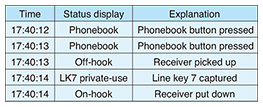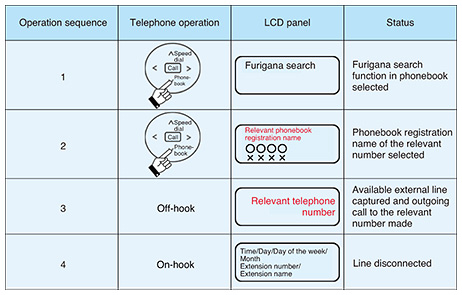 |
|||||||
|
|
|||||||
|
Practical Field Information about Telecommunication Technologies Vol. 16, No. 6, pp. 58–61, June 2018. https://doi.org/10.53829/ntr201806pf1 Investigation of Unintentional One-ring Outgoing CallsAbstractThis article describes an actual problem case involving unintentional one-ring outgoing calls. The Network Interface Engineering Group investigated the mechanism of the problem and devised some solutions to prevent a recurrence. This is the forty-sixth article in a series on telecommunication technologies. This contribution is from the Network Interface Engineering Group, Technical Assistance and Support Center, Maintenance and Service Operations Department, Network Business Headquarters, NTT EAST. Keywords: PBX, IP phone, IP packet capture 1. IntroductionThe Network Interface Engineering Group conducts investigations and provides technical support to solve highly technical problems that occur in Internet protocol (IP) network services such as FLET’S HIKARI NEXT. In the investigations, we often capture and analyze IP packets to find out the root causes of the problem and then present practical solutions to enable continuous use of the services by our customers. However, IP network services accommodate not only an Ethernet-based device but also a VoIP (voice over Internet protocol) gateway, which converts IP signals to non-IP signals such as analog or integrated services digital network (ISDN) signals. Therefore, it is necessary to choose proper measurement devices such as oscilloscopes, protocol analyzers, or other terminal-specific measurement devices to collect and analyze data when we face technical problems. In this article, we introduce a case involving unintentional one-ring calls that occurred in a business phone system using extension phones. The details of the problem and our analysis method are also presented in the following sections. 2. Problem overview and investigation methodA customer (User A) recognized that the one-ring calls were happening several times a day and therefore contacted the maintenance provider of their private branch exchange (PBX). By checking the call logs of the PBX, the maintenance provider found that the one-ring calls were coming from one particular number. Therefore, User A also contacted the caller suspected of making the one-ring phone calls so as to solve the problem. The caller (User B) was using the optical IP telephone service called HIKARI DENWA OFFICE A (ACE) with the Netcommunity SYSTEM αNX II type-L (NXIIL) phone system. The NXIIL system data indicated that the telephone number of User A was registered in the phonebook of the NXIIL system. We checked the call history data saved on all of the phones deployed in User B’s system and determined that only one particular phone was used to call User A. However, the user of the phone claimed that he had not make the phone calls. Suspecting a device failure, the field maintenance personnel performed the usual maintenance procedures such as turning the power of the NXIIL main equipment off/on and replacing the central control unit (CCU)*1. These procedures did not solve the problem, however, so the Technical Assistance and Support Center conducted an investigation of the matter. The configuration of the user networks and data collection points is shown in Fig. 1. We collected: (1) incoming call logs of the PBX at the call-terminating side
3. Analysis of collected dataWe describe in this section how we analyzed the data to detect the root of the problem. 3.1 Incoming call log of PBXThe incoming call log on the User A side PBX showed that extremely short calls (less than one second from receipt to disconnection of call) occurred four times during the investigation. Moreover, all of the calls had the same identification number registered in the NXIIL system. 3.2 IP packet capture dataWe analyzed the captured IP packet data and found that INVITE signals (request signals to establish calls in the session initiation protocol (SIP)*3) were sent from User B to User A. Note that the sending time of the INVITE signals all agreed with the recorded time of the one-ring calls in the PBX logs described above. Furthermore, CANCEL request signals (shutdown signals of the ongoing session in SIP) were also sent from the User B side. Therefore, the calls were terminated by the reception of 487 Request Terminated (termination of request signals in SIP) messages sent from the User A side (Fig. 2).
3.3 αLAN distribution monitoring system logThe actual user operations of the IP extension phone on the User B side were revealed by analyzing the data collected by the αLAN distribution monitoring system. The estimated user operations were as follows; first, the phonebook button was pushed twice. Then an off-hook/on-hook operation was done. Note that these were done within approximately one second (see Table 1).
3.4 NXIIL main equipment system dataUpon checking the common phonebook data, we found that the telephone number of User A was registered as a first entry when the user selects a furigana (Japanese syllabary character) search function.
4. Mechanism of unintentional one-ring callsWe found that User B used the off-hook external line capture function in the NXIIL system. This enables the user to make an outgoing call only by an off-hook operation—without pushing any number buttons—when an arbitrary number registered in the phonebook function is selected (i.e., when the number is displayed on the telephone’s liquid crystal display (LCD) panel). When a business phone is connected to a HIKARI DENWA line or an ISDN line, the call session is established in the first few milliseconds. Therefore, the outgoing signal is delivered to the other party even when an on-hook operation is performed right after the off-hook. As a result, the call appears as a one-ring call on the User A side (Table 2). Note that the one-ring call does not occur when a business phone is connected to an analog line.
5. Inference of causeFrom the captured data described in the previous section, we speculated the sequence of events as follows. First, the user (User B) pushed the phonebook button in order to use the “a-ka-sa-ta-na” (A-B-C-D-E) line search function of the phonebook. However, the user accidentally pressed the phonebook button twice. Then the user tried to clear the display by doing off-hook/on-hook operations since the first telephone number entry in the phonebook (wrong destination number) was displayed on the LCD. As a result, the call appeared as a one-ring call on the User A side. In general, pushing a clear button on the telephone is recommended to cancel the operation instead of using the off-hook/on-hook operation. 6. CountermeasuresWe proposed the following three countermeasures to prevent unintentional calls to a particular telephone number. (1) Users should be sure to use the clear button rather than performing off-hook/on-hook operations to clear the telephone number shown on the LCD. (2) Register a dummy telephone number (e.g., an unused, short-digit number) as the first entry in the phonebook to avoid making an unintentional call, If the user prefers to use off-hook/on-hook operations instead of the clear button to cancel the operation, no call will go through to the dummy number. (3) Disable the off-hook external line capture function of the business phone to prevent automatic external line capture when performing off-hook operations. The customer of the call-originating side (User B) decided to perform countermeasures (1) and (2). As a result, no unintentional one-ring outgoing calls have subsequently occurred. 7. ConclusionIn this article, we introduced a problem case involving unintentional one-ring calls in a business phone system using extension phones. The problem was solved by analyzing captured Ethernet IP packets and controlling signals between the main business phone equipment (NXIIL) and the IP extension phone. The Technical Assistance and Support Center works diligently to solve such troublesome problems and ensure continuous service for our customers. |
|||||||












